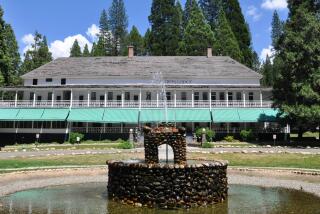These national park hotels were built in 1927. Their similarities end there
Yosemite’s Ahwahnee Hotel and the Inn at Death Valley both date to 1927. But beyond that, their stories are as different as a pine tree and a palm.
The Ahwahnee
The Ahwahnee, built in 1927 in Yosemite National Park, has 97 rooms and 24 cottages, all designed in a stately yet rustic style by architect Gilbert Stanley Underwood, who also designed the Zion and Bryce Canyon lodges, along with Old Faithful Lodge in Yellowstone National Park.
Here, the young Ansel Adams grabbed meals between wilderness photo sessions and oversaw the choirs singing at elaborate winter Bracebridge Dinners. Here, also, thousands of injured Navy personnel convalesced during World War II when the hotel was converted to a hospital.
The queen of England spent a night here in 1983, and President Obama and his family stayed here in 2016.
The hotel, shaped like a Y, features two big rooms on its ground floor: the Great Room, where guests and visitors sink into couches and armchairs to warm their feet near oversize fireplaces, and the dining room, where rustic chandeliers hang above seating for 300.
“These places are wonderful,” tour guide Marty Anderson told visitors, “because they help people discover themselves.”
Though the hotel is owned by the National Park Service, it is operated by Philadelphia-based Aramark, a concession giant that runs dozens of attractions, including Hearst Castle and Colonial Williamsburg in Virginia.
Yosemite is said to be one of the most valuable concessions in the park system, with more than 4 million visitors a year. But the concessionaire’s role comes with red tape. Each year, park concessionaires must submit rates to the NPS for approval, and any changes to historic sites receive close government oversight.
These two fancy national park hotels both go back to 1927. Are they worth a splurge? Here’s my head-to-head test.
Ahwahnee ratings
In its review of Aramark in 2018, the National Park Service rated the concessionaire’s overall Yosemite operation (including the Ahwahnee) as “marginal,” with a score of 69 out of 100.
That report did note that surveys showed 81% overall customer satisfaction with the Ahwahnee (then known as the Majestic Yosemite Hotel because of a trademark dispute). But in September 2018, inspectors from the American Automobile Assn. reported that the Ahwahnee had slipped.
That month, AAA dropped its rating of the Ahwahnee from four diamonds — which it had held since 1991 — to three diamonds. In results released in February, AAA again rated the Ahwahnee at three diamonds.
Aramark spokeswoman Lisa Cesaro said that AAA diamond rankings tend to reward newer properties and that “due to the historic nature of the hotel, there are key areas that we cannot change.”
Yet another challenge for Aramark occurred in January, when an outbreak of gastrointestinal illness afflicted about 170 visitors in Yosemite Valley, including some guests at the Ahwahnee who spoke to the San Francisco Chronicle.
Two of the 170 ill were later diagnosed with norovirus, which can spread through contact with an infected person, by touching a contaminated surface or object or by consuming contaminated food or liquid. No additional troubles have been reported since January.
Since 2016, Cesaro said, the company has invested about $4 million in the Ahwahnee, renovating guest rooms and the hotel bar and installing new kitchen equipment. There are plans to refurbish the Great Lounge’s historic furniture and renovate hotel suites.
The Inn at Death Valley
While the Ahwahnee was rising in the Yosemite Valley 93 years ago, the sellers of Borax laundry soap (made from Death Valley minerals) were putting up a hotel at Furnace Creek in Death Valley. It was modest, just 12 rooms on a hillside near natural springs.
As word of the area’s harsh beauty spread, Death Valley’s inhospitable nature became its big selling point. By 1933, when the area was designated a national monument, the hotel had expanded four times.
One early ad said Death Valley had “all the advantages of hell without the inconveniences.” Apparently, the ads worked. Attendance kept growing, and national park status followed in 1994.
Nowadays, plenty is different, including hotel management and the inn’s name, which in 2017 was changed from the Inn at Furnace Creek to the Inn at Death Valley.
The inn is run by Xanterra, an Aramark rival that manages luxury operations such as Colorado’s Broadmoor Resort, Georgia’s Sea Island and Windstar Cruises. (Xanterra is part of the empire of Philip Anschutz, the Colorado mogul who controls sports-and-entertainment giant AEG and the L.A. Galaxy soccer team.)
Unlike the Ahwahnee and most national park hotels, the Inn at Death Valley and the land beneath it are owned by Xanterra. And the Inn at Death Valley, though designed by prominent architect Albert C. Martin, is not on the National Register of Historic Places.
Boating, stand-up paddle boarding, surfing and whale watching are among the activities of this popular Orange County town halfway between L.A. and San Diego.
That means Xanterra doesn’t need government approval for price increases, renovations or other matters that are the subject of negotiation in most national parks and historic sites. It’s “private property surrounded by Death Valley National Park,” said park spokeswoman Abigail Wines.
The same situation applies at the neighboring Ranch at Death Valley, a complex of restaurants, shops and hotel rooms also run by Xanterra.
That may also help explain Xanterra’s readiness to invest an estimated $100 million in Death Valley since 2017. Between May 2017 and February 2018, the company undertook a major renovation at the inn that rearranged its rooms and grounds, added 22 high-end casitas ($550 and up) to 66 existing rooms and turned the previously seasonal inn into a year-round operation.
AAA gives the Inn at Death Valley a four-diamond rating, meaning it’s in the top 6% of all properties inspected.
Still, there’s no guarantee how any lodging will strike any traveler.
The morning I left Death Valley, I watched four hungry-looking men in the inn’s dining room.
“Get ready,” one of them said, “for the greatest date pancakes in the world.”
The waitress then gently broke the news that date pancakes were no longer on the menu. The men whispered among themselves, then stood and filed out.
My breakfast was grand. In fact, I had just decided that the Inn at Death Valley had bested the Ahwahnee and that it deserved to be called the best-run luxury park lodge in California. But for those four guys: no date pancakes, no deal.
More to Read
Sign up for The Wild
We’ll help you find the best places to hike, bike and run, as well as the perfect silent spots for meditation and yoga.
You may occasionally receive promotional content from the Los Angeles Times.








